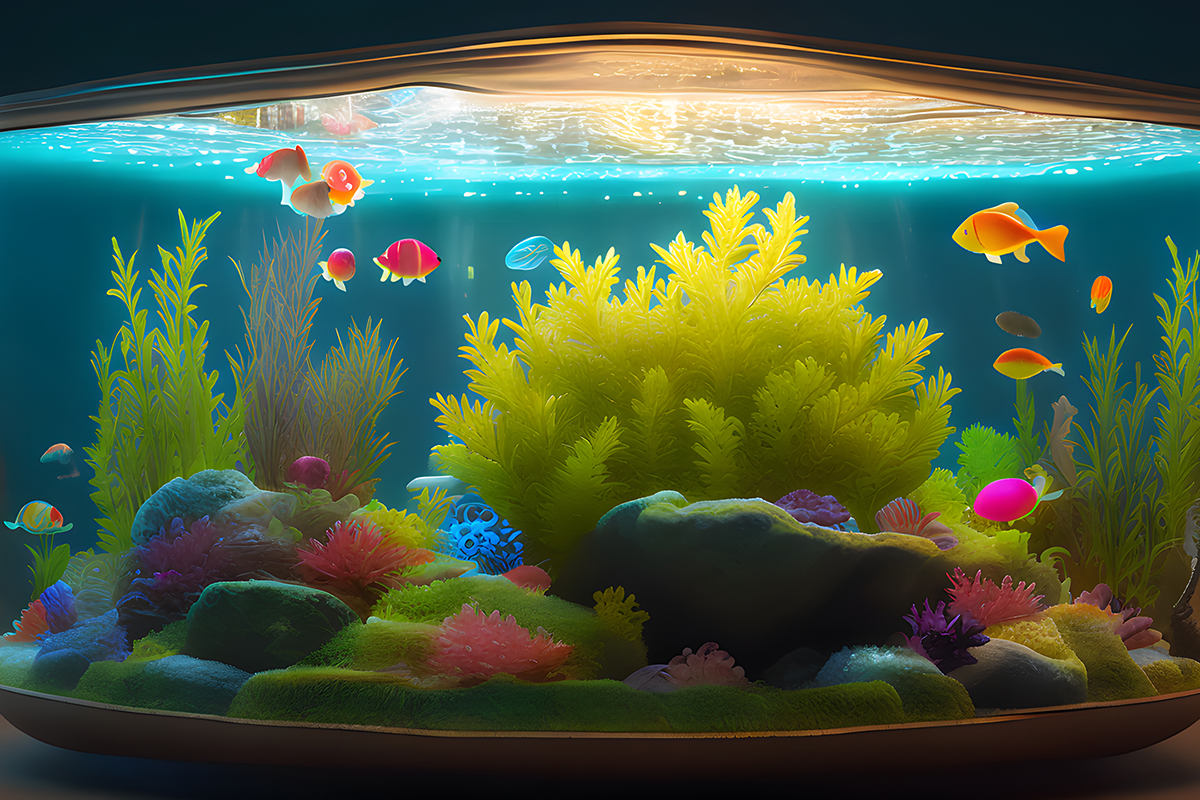Aquarium lighting
Aquarium lighting is a purposeful application of of artificial light within an aquarium to illuminate and enhance the visual and biological aspects of the aquatic environment. Aquariums are visually appealing and can serve as captivating displays in homes, offices, and public spaces. Watching colorful fish swimming amid vibrant plants and decorations has a calming and stress-relieving effect, contributing to the overall aesthetics of the environment. They also provide a tangible way for people to learn about aquatic ecosystems, marine life, and the importance of conservation. Public aquariums often play a significant role in marine education and awareness. The availability of a wide variety of fish species, invertebrates, plants, and aquarium accessories allows hobbyists to create diverse and personalized ecosystems. Whether it's a freshwater or saltwater aquarium, there are endless possibilities for customization to suit individual preferences and interests. Aquarium lighting serves multiple functions, ranging from supporting the photosynthetic processes of plants and corals to providing visibility for observation and aesthetic enjoyment. This specialized lighting allows hobbyists and professionals to control the amount, spectrum, and duration of light exposure in the aquarium.
Orchestrating light and life in your underwater oasis
Aquarium lighting serves various functions, encompassing aesthetics, biological support, day-night simulation, customization for different species, specialized lighting for reef aquariums, showcasing aquascape designs, scientific research, and educational displays. Many aquarium hobbyists appreciate the visual appeal that proper lighting can bring to their aquarium setups. Artificial lighting allows them to showcase the vibrant colors of fish, plants, and other aquatic organisms. This aesthetic enhancement is a significant factor driving the popularity of aquarium lighting. Aquarium lighting is crucial for supporting the biological processes within the tank. Photosynthetic organisms, such as aquatic plants and certain corals, rely on light for photosynthesis. Proper lighting conditions ensure the growth, health, and reproduction of these organisms, contributing to the overall balance of the aquarium ecosystem. Some advanced aquarium lighting systems are designed to simulate natural day-night cycles. This not only adds realism to the aquarium environment but also benefits the well-being of the inhabitants. For example, certain fish species may have specific behavioral patterns tied to natural light cycles, and replicating these conditions can promote their natural behaviors. Different aquatic species have varying lighting requirements. Some fish and plants thrive in low-light conditions, while others require bright and intense lighting. The ability to customize and adjust the lighting parameters allows aquarium enthusiasts to create specific environments tailored to the needs of their chosen species. In reef aquariums, where coral growth is a focal point, specialized lighting is often employed. Coral health and coloration are highly dependent on the right spectrum and intensity of light. Aquarium lighting systems designed for reef tanks provide the specific wavelengths required for coral photosynthesis and growth. Aquarium enthusiasts often create intricate aquascapes using various elements such as rocks, driftwood, and substrate. Proper lighting is essential to highlight and showcase these designs, bringing out the textures and details of the aquascape for a visually pleasing effect. In addition to hobbyist applications, aquarium lighting is also used in scientific research settings. Researchers studying aquatic ecosystems may utilize controlled lighting conditions to observe and analyze the behavior, physiology, and interactions of aquatic organisms.
Dive into the lighting science
The unique features of
LED lighting, including energy efficiency, long lifespan, customizable spectrum, low heat emission, compact design, dimming capabilities, and controllability, have made LED lighting integral to aquarium setups. These features contribute to creating optimal conditions for aquatic life, enhancing the visual appeal of aquariums, and providing a sustainable and efficient lighting solution for aquarium enthusiasts. The energy efficiency of LED aquarium lights is beneficial for aquarium owners as it helps reduce electricity costs and contributes to a more sustainable and environmentally friendly lighting solution. The durability of LED aquarium lights means that they require less frequent replacement, reducing maintenance efforts and costs for aquarium enthusiasts. This long lifespan is particularly advantageous in aquariums, where access to the
lighting fixtures may be challenging. The low heat emission of LEDs helps maintain a stable temperature within the aquarium, preventing overheating and potential harm to the aquatic inhabitants. The compact fixture design enabled by LED technology allows for more flexibility in positioning the lights to achieve the desired visual and biological effects within the aquarium.
The dimming capabilities of LED aquarium lights offer a versatile and customizable lighting solution for aquarium enthusiasts. It not only adds to the aesthetic appeal of the aquarium but also contributes to the well-being of the aquatic life by replicating natural light cycles and providing a controlled and dynamic lighting environment. LED technology offers high precision in spectral engineering, allowing for fine-tuning of the light spectrum to meet the specific needs of different aquatic organisms, promoting their growth, health, and natural behaviors within the aquarium environment. LED technology enables dynamic control of SPD, allowing for the spectrum of light to be adjusted in real-time to meet specific requirements. Many LED aquarium lights feature multi-color LEDs, which are individual diodes that emit light at different wavelengths or colors. By adjusting the intensity of each color diode, aquarium enthusiasts can create a diverse spectrum of light. Color mixing involves blending different colors to achieve the desired overall color and spectrum within the aquarium. In addition to multi-color LEDs, some aquarium lights incorporate multi-
CCT LEDs. These LEDs have varying correlated color temperatures (CCTs), which represent different color temperatures of light. By adjusting the intensity of multi-CCT LEDs, users can change the overall color temperature of the light emitted. This feature is crucial for simulating natural lighting conditions, including sunrise, daylight, and sunset, to support the natural behaviors and biological processes of the aquarium's inhabitants.
Types of LED aquarium lights
LED aquarium lights come in various types based on their application, and the choice of the light depends on the specific needs of the aquarium setup. Different types cater to freshwater, planted, and reef tanks, each with its own set of features to support the growth and well-being of the aquarium inhabitants. Freshwater LED Lights are specifically designed for use in freshwater aquariums that house fish, invertebrates, and live plants. In addition to benefiting fish, these lights support the photosynthesis process for live plants in the aquarium. The spectrum of light provided helps plants in the tank to thrive by facilitating their energy production. These lights are crafted to highlight and enhance the vibrant colors of fish, making them more visually appealing. This is particularly important for aquarium enthusiasts who appreciate the aesthetic beauty of their aquatic pets. Marine LED aquarium lights are designed for use in marine aquariums, catering to the needs of a variety of marine life, including fish, invertebrates, and certain types of corals. These lights offer specific features to create an optimal environment for the inhabitants of marine aquariums. Planted tank LED aquarium lights are tailored to meet the unique needs of aquariums with live aquatic plants. They provide a spectrum of light that supports photosynthesis and fosters healthy plant growth, often including customizable features for adjusting color temperature and intensity to create an ideal environment for the planted tank. Reef LED aquarium lights are specialized for saltwater aquariums with corals, anemones, and other reef inhabitants. Coral LED aquarium lights are specialized for reef aquariums, with a specific focus on supporting the growth and coloration of corals. They provide high-intensity light in the blue and violet spectrum, often with features like individual color channel control and programmable lighting modes to offer a customized and optimal lighting environment for coral health and aesthetics.
LED grow lights for aquarium plants are tailored to meet the specific needs of live aquatic plants in aquariums. Aesthetic or mood LED aquarium lights are designed to go beyond basic illumination. They provide a means for users to express their creativity, personalize the aquarium's ambiance, and prioritize the visual aspect of the setup.
Designs and mounting options
LED aquarium lights come in various designs and mounting options.
LED strip lights are long, narrow fixtures that provide a uniform spread of light. They are suitable for smaller aquariums or for use as supplementary lighting in larger setups. They are often mounted directly onto the aquarium hood or cover.
LED Panel lights consist of flat, rectangular panels containing an array of LEDs. They can be suspended above the aquarium using adjustable mounting brackets or hung from a ceiling. Hanging
LED pendant lights are suspended from the ceiling or a mounting structure above the aquarium. They often have a sleek and modern design. This design is suitable for larger aquariums, providing even coverage of light. Clamp-on LED aquarium lights feature a clamp mechanism that allows them to be attached to the rim or edge of the aquarium. They are adjustable and provide flexibility in positioning. These lights are often used for small aquariums or specific areas within larger tanks. LED aquarium lights with adjustable arms allow users to extend or retract the light fixture over the aquarium. The arms can be adjusted both horizontally and vertically. This design is convenient for providing targeted lighting to specific areas of the tank. Submersible LED aquarium lights are designed to be placed underwater in the aquarium. They are often used for decorative purposes or to highlight specific features within the tank. Rimless tank lights are often mounted directly onto the rimless tank, providing a clean and unobtrusive look. Some LED aquarium lights come in modular systems where multiple modules can be connected to create a custom lighting array. This allows for scalability and adaptability to different tank sizes. Cabinet-mounted lights are designed to be integrated into the aquarium cabinet or hood. This design provides a neat and concealed lighting solution. Some LED aquarium lights are designed to be retrofitted into existing light fixtures. These retrofit kits allow users to upgrade their traditional lighting systems to energy-efficient LED technology. Many LED aquarium lights come with built-in mounting hardware, such as adjustable brackets, to simplify the installation process. These brackets can be attached to the aquarium rim or used for suspended mounting.
Lighting control
LED aquarium lights often include a control system that allows users to adjust brightness levels, color spectrum, and other lighting parameters. Controls can be manual, with buttons or knobs on the fixture, or digital, with remote controls or smartphone apps for more advanced settings. Advanced LED aquarium lights may feature digital displays that show current settings and allow users to navigate through different options. The display provides a visual interface for adjusting parameters. Timers are commonly integrated into LED aquarium lights, allowing users to set specific on/off schedules. This feature ensures that the aquarium's lighting follows a consistent and programmed cycle, promoting the well-being of the inhabitants. Aquarium owners can use advanced
lighting controllers to create dynamic lighting effects, simulate weather patterns, and gradually change light intensity throughout the day. This level of control enhances the overall aesthetics of the aquarium and supports the specific needs of the inhabitants. LED lights with sunrise and sunset simulation features gradually adjust the light intensity and color temperature to replicate the natural transitions between day and night. This helps reduce stress on aquarium inhabitants. Many LED aquarium lights include moonlight modes that provide a low-intensity, bluish light during the night. This mimics moonlight conditions and supports the natural behaviors of nocturnal species. Moonlight modes are often programmable. Some LED aquarium lights offer weather effects simulation, allowing users to create dynamic lighting conditions such as cloud cover or lightning storms. These effects can be programmed for added visual interest. Some LED aquarium lights include a remote control, providing users with the convenience of adjusting settings from a distance. Remote controls often have intuitive buttons or touch panels for easy operation. LED aquarium lights equipped with
Bluetooth or Wi-Fi connectivity enable users to control the lights using smartphone apps. These apps offer a user-friendly interface with graphical controls and may include additional features such as scheduling and programming. LED aquarium lights can be integrated with aquarium controllers, centralizing the control of various aquarium equipment. This allows for synchronized and automated management of lighting, filtration, and other systems.







